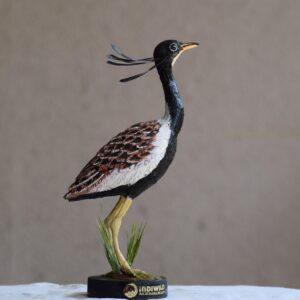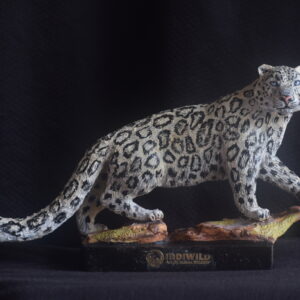Common Kingfisher bird sculpture/model
The Common kingfisher occurs throughout Europe and in Asia as far to the east as Japan, and south of the Sahara in Africa. Common kingfishers live year round in the south, while northern populations fly south in winter away from the freezing water. They are found in wetlands and on the shores streams, ponds and lakes.
Sculpture size -10 x 5 inches
Material Used : Polyresin
A resin sculpture is a statue or other piece of three-dimensional art that has been cast using fiberglass resin. Resin is a fairly lightweight, durable material that can be painted and glazed to look like stone, porcelain, bronze or marble. It is used to manufacture a wide variety of products
The common kingfisher (Alcedo atthis), also known as the Eurasian kingfisher and river kingfisher, is a small kingfisher with seven subspecies recognized within its wide distribution across Eurasia and North Africa. It is resident in much of its range, but migrates from areas where rivers freeze in winter.
This sparrow-sized bird has the typical short-tailed, large-headed kingfisher profile; it has blue upperparts, orange underparts and a long bill. It feeds mainly on fish, caught by diving, and has special visual adaptations to enable it to see prey under water. The glossy white eggs are laid in a nest at the end of a burrow in a riverbank.
This species has the typical short-tailed, dumpy-bodied, large-headed, and long-billed kingfisher shape. The adult male of the western European subspecies, A. a. ispida has green-blue upperparts with pale azure-blue back and rump, a rufous patch by the bill base, and a rufous ear-patch. It has a green-blue neck stripe, white neck blaze and throat, rufous underparts, and a black bill with some red at the base. The legs and feet are bright red.[7] It is about 16 centimetres (61⁄2 in) long with a wingspan of 25 cm (10 in),[7] and weighs 34–46 grams (13⁄16–15⁄8 oz).[8] The female is identical in appearance to the male except that her lower mandible is orange-red with a black tip. The juvenile is similar to the adult, but with duller and greener upperparts and paler underparts. Its bill is black, and the legs are also initially black.[7] Feathers are moulted gradually between July and November with the main flight feathers taking 90–100 days to moult and regrow. Some that moult late may suspend their moult during cold winter weather.[citation needed]
The flight of the kingfisher is fast, direct and usually low over water. The short, rounded wings whirr rapidly, and a bird flying away shows an electric-blue “flash” down its back.[8]
In North Africa, Europe and Asia north of the Himalayas, this is the only small blue kingfisher. In south and southeast Asia, it can be confused with six other small blue-and-rufous kingfishers, but the rufous ear patches distinguish it from all but juvenile blue-eared kingfishers; details of the head pattern may be necessary to differentiate the two species where both occur.[7]
The common kingfisher has no song. The flight call is a short, sharp whistle chee repeated two or three times. Anxious birds emit a harsh, shrit-it-it and nestlings call for food with a churring noise.[7]
The common kingfisher is widely distributed over Europe, Asia, and North Africa, mainly south of 60°N. It is a common breeding species over much of its vast Eurasian range, but in North Africa it is mainly a winter visitor, although it is a scarce breeding resident in coastal Morocco and Tunisia. In temperate regions, this kingfisher inhabits clear, slow-flowing streams and rivers, and lakes with well-vegetated banks. It frequents scrubs and bushes with overhanging branches close to shallow open water in which it hunts. In winter it is more coastal, often feeding in estuaries or harbours and along rocky seashores. Tropical populations are found by slow-flowing rivers, in mangrove creeks and in swamps.[7]
Common kingfishers are important members of ecosystems and good indicators of freshwater community health. The highest densities of breeding birds are found in habitats with clear water, which permits optimal prey visibility, and trees or shrubs on the banks. These habitats have also the highest quality of water, so the presence of this bird confirms the standard of the water.[11] Measures to improve water flow can disrupt this habitat, and in particular, the replacement of natural banks by artificial confinement greatly reduces the populations of fish, amphibians and aquatic reptiles, and waterside birds are lost.[12] It can tolerate a certain degree of urbanisation, provided the water remains clean.[citation needed]
This species is resident in areas where the climate is mild year-round, but must migrate after breeding from regions with prolonged freezing conditions in winter. Most birds winter within the southern parts of the breeding range, but smaller numbers cross the Mediterranean into Africa or travel over the mountains of Malaysia into Southeast Asia. Kingfishers migrate mainly at night, and some Siberian breeders must travel at least 3,000 km (1,900 mi) between the breeding sites and the wintering areas
Like all kingfishers, the common kingfisher is highly territorial; since it must eat around 60% of its body weight each day, it is essential to have control of a suitable stretch of river. It is solitary for most of the year, roosting alone in heavy cover. If another kingfisher enters its territory, both birds display from perches, and fights may occur, in which a bird will grab the other’s beak and try to hold it underwater. Pairs form in the autumn but each bird retains a separate territory, generally at least 1 km (1⁄2 mi) long, but up to 3.5 km (21⁄4 mi) and territories are not merged until the spring.[7]
The courtship is initiated by the male chasing the female while calling continually, and later by ritual feeding, with copulation usually following.[8]
The nest is in a burrow excavated by both birds of the pair in a low vertical riverbank, or sometimes a quarry or other cutting. The straight, gently inclining burrow is normally 60–90 cm (25–35 in) long and ends in an enlarged chamber.[8] The nest cavity is unlined but soon accumulates a litter of fish remains and cast pellets.[13]
The common kingfisher typically lays two to ten glossy white eggs, which average 1.9 cm (3⁄4 in) in breadth, 2.2 cm (7⁄8 in) in length, and weigh about 4.3 g (5⁄32 oz), of which 5% is shell.[5] One or two eggs in most clutches fail to hatch because the parent cannot cover them. Both sexes incubate by day, but only the female incubates at night. An incubating bird sits trance-like, facing the tunnel; it invariably casts a pellet, breaking it up with the bill. The eggs hatch in 19–20 days, and the altricial young are in the nest for a further 24–25 days, often more.[7] Once large enough, young birds will come to the burrow entrance to be fed.[13] Two broods, sometimes three, may be reared in a season.














Reviews
There are no reviews yet.